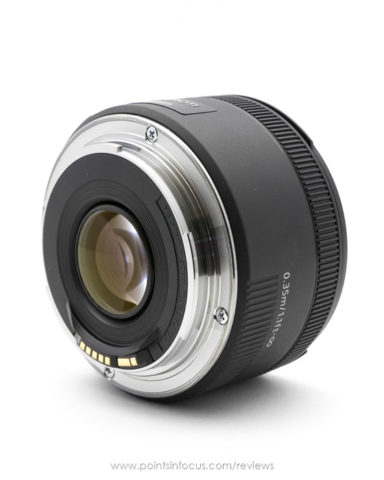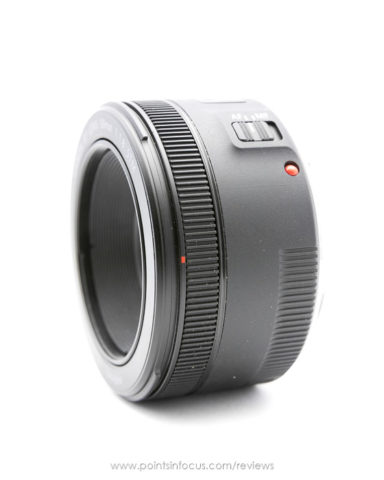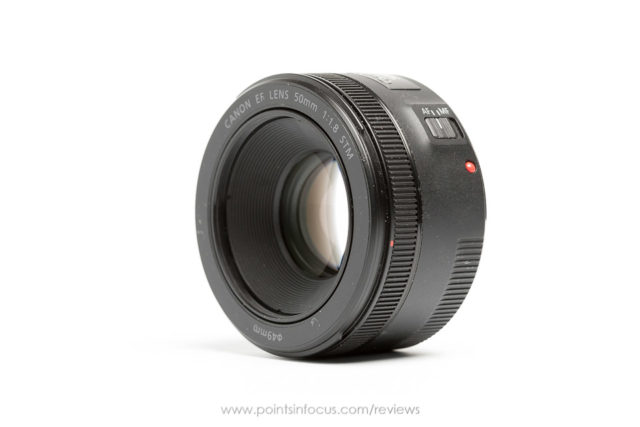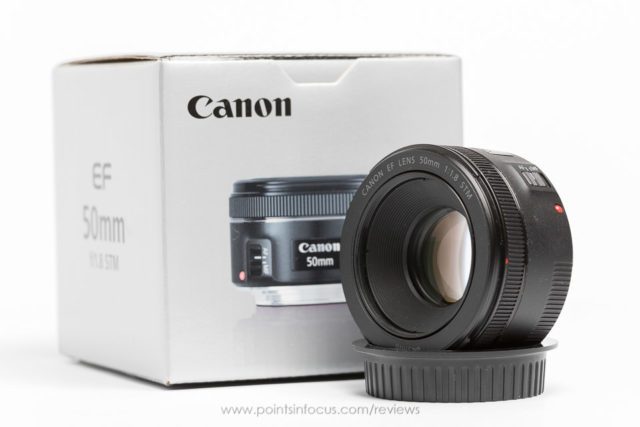Canon EF 50mm f/1.8 STM Review
If you look up the word cheap in a dictionary, one of the definitions will roughly be, “Low priced, inexpensive,” another will be, roughly, “of poor quality.” For me personally, when I say something is cheap I mean it’s of poor quality; otherwise I say it’s inexpensive. As far as lenses go, at $125 full list price, the Canon EF 50mm f/1.8 STM is inexpensive; regardless of price, its predecessor the Canon EF 50mm f/1.8 II is cheap.
I’ve previously reviewed the EF 50mm f/1.8 II, and my feelings on the lens are far from glowing. In my opinion, it’s not a lens worth buying. Fortunately, it’s been effectively replaced by Canon with the EF 50mm f/1.8 STM. Suffice to say, I couldn’t feel any more differently about the EF 50mm f/1.8 STM than I did about its predecessor.
There was a lot to fault in the old EF 50mm f/1.8 II. In my experience, the build quality was crap, the plastic lens mount was fragile, the AF system was inaccurate garbage, and the manual focus ring was sloppy and had a short throw making it very hard to focus manually. None of which are problems with the new EF 50mm f/1.8 STM.
And that doesn’t even get into the meat of the optical improvements Canon has made. Like the rounded 7-bladed aperture, up from 5 straight blades. Or vastly improved optical design and coatings that renders improved resolving power. Or the shorter minimum focus distance that improves the maximum magnification.
The new EF 50mm f/1.8 STM fixes pretty much every problem its predecessor had. In fact, across the board the 50/1.8 STM is just a much better lens.
Design and Build
Judging the build quality of a lens is something that’s challenging at best. I’ve seen all kinds of arbitrary standards trotted out by photographers for what they personally consider a mark of quality. Use of metal is frequently used as evidence of high build quality. Weight is also frequently is used as an indicator of quality, with heavier lenses being cited as being better built.
The reality though is that it’s often quite problematic to just judge the build quality of a lens by what can be seen on the outside. Mostly metal lenses have been know to have weaknesses (for example Canon’s EF 50mm f/1.4 USM has a fragile AF gear box), and a great many largely plastic lenses have been made that survive serious use just fine.
In my opinion, what you want to look for is the most appropriate use of materials for a given design and in the right places.
In the age old debate between plastic and metal, there are pros and cons to each. Metal generally will be more wear resistant, and because it will dent and deform instead of crack or shatter it potentially could be more resilient to abuse. On the other hand, plastics are often lighter, more thermally stable, and don’t conduct heat very well — which means handling them doesn’t suck the heat out of your fingers when it’s cold out.
So how does all of this sit with the EF 50mm f/1.8 STM?
The vast majority of the lens is plastic. The lens is small, and light, and that size makes generally much harder to damage; at least from impacts. Durability, at least from an external impact perspective, doesn’t really appear to be a big concern.
The one place that might be problematic, is the inner lens barrel used for focusing. Though this can be effectively protected with the addition of a lens hood, which I’ll talk about further in a bit.
However, while the majority of the body is plastic, Canon has improved things where they matter. Specifically, Canon has equipped this lens with a metal lens mount.

While I don’t have any real problems with plastic in most places on a lens, the lens mount is one place I really want to see metal, but probably not for the reason most would suspect. The reason I want to see a metal mount is because of its resistance to wear on a critical alignment surface.
Every time the lens is mounted and dismounted, the interfacing surfaces wear a little. When everything is metal, and of the same or similar hardness, the wear is very minimal and the lens mount should retain it’s accuracy for a long time. However, when one mount is plastic, it will wear more than if it was metal. As the lens is mounted and dismounted repeatedly, it will eventually become sloppy and that can result in alignment issues.
So with that in mind, having a metal mount on the EF 50mm f/1.8 STM is definitely an improvement over the plastic mount on the old lens.
Finally, there’s the overall fit and finish as far as build quality goes.
For a plastic product, there are a couple of areas I look at when judging the fit and finish. First I look at the mold lines. Plastic parts always have mold lines, it’s an unavoidable artifact of the manufacturing process. For the most part these aren’t a structural joint or weakness, they’re an artifact of the mold needing to separate to allow the piece to be removed. However, sloppy mold lines does indicate sloppy manufacturing and finishing. The second are is the joints between separate pieces.
In both cases, Canon has done a very good job with the finish of the EF 50mm f/1.8 STM. There are mold lines, but they’re extremely fine to the point of being something I really had to look for. Likewise, all seams between various parts are tight and uniform.
The overall appearance is further helped by Canon’s move to a matte black surface finish too. The old EF 50mm f/1.8 II was relatively shiny plastic, and it just felt cheap; never mind the glossy surface didn’t hide any imperfections in the manufacture. The new matte black finish feels good in my hand, and isn’t slick or slippery and just plain looks good.
Lens Hood
There’s pretty much nothing on the 50mm f/1.8 STM that hasn’t been touch by Canon in a good way. The lens hood is no exception.
The old EF 50mm f/1.8 II used the same weird throwback hood design that its predecessor used. This was an oddball two part system that consisted of a screw in quick release ring, and the hood that clipped on to that. Admittedly this was consistent with Canon’s early EOS lens hood designs (back in the late 1980s), but it’s certainly an odd solution today when we’re use to bayonet mount hoods.
Canon has tossed the old odd-ball solution and move to a standard bayonet hood for the EF 50mm f/1.8 STM. Moreover, the ES–68 hood follows Canon’s current design practices, meaning it locks in position and has a button to release it so it can be turned.
The bigger question is perhaps whether or not you even need a hood.
For most lenses my answer to that question would be yes. But the 50/1.8 STM is a bit of an exception to that. The front elements are already recessed the better part of 1/2 an inch. There’s already a good amount of shading and protection built into the lens on its own.
On the other hand, this is an overall linear extension lens design. This means the inner lens barrel and all the glass elements extends out the front of the lens. When extended, the inner lens barrel and by extension the AF drive system is unprotected from impacts of any kind. The new hood certainly will protect the AF mechanism from being accidentally banged into when walking around.
Personally, I’m not yet of the opinion I need a hood to protect my lens from damage or deal with glare. That said, one thing I won’t be doing is buying Canon ES–68 hood, which at $24.95 costs 1/5th of what the lens did. At least not when a 3rd party, like this Fotasy hood(Affiliate Link) can be had for less than $10.
Filter Mount
While I’m on the topic of design and build, its also worth mentioning the filter mounting situation. The 50/1.8 STM uses 49 mm screw in filters if you’re inclined to use filters with it.
Given the recessed nature of the front element and general inexpensive of the lens, I don’t see much value in putting a protective (UV or clear) filter on it. Moreover, given how inexpensive the lens is, a good one will cost an appreciable amount the lens’s value. Something reasonable from the likes of Hoya or B+W will run around $15–20.
The good news though is that the filter mount doesn’t rotate, and so filters like a circular polarizer or creative effect filters can be used without any additional hassles.
Fifty millimeters is a long enough focal length, especially on a crop body, that a polarizer can be used without risk of creating unevenness in the sky. That said, a reasonable quality 49 mm circular polarizer will run $30–50.
Personally, given that 49 mm filter threads are used on so few Canon lenses, if I was to run a filter (like a polarizer) on this lens, I would buy a step up ring and use a polarizer that’s a more common size for Canon lenses (like 58 mm).
If you’re looking to mount a rectangular filter holder to this lens, there are options. Lee does make 49 mm mount for their Seven5 system as well as their standard 100 mm system. Formatt-Hitech users will need to get a 49 to 82mm stem down adapter to use that 100 mm system with this lens.
Focusing and Focus Handling
Let me start this section with a brief aside back to build and design and talk about the distance scale and the actual design of the focus ring itself.
Like its predecessor, the EF 50mm f/1.8 STM doesn’t include a distance scale. I don’t see this as a detriment either. Modern AF lens distance scales have become all but useless compared to their manual focus counter parts, and I see little value in including one on a lens like this.

As for the focus ring, at 1/4 inch (6.5 mm) wide by my measure it’s not very wide. Moreover, unlike most other Canon lenses, it doesn’t stand proud of the lens barrel; though in my experience this isn’t a problem for hand usage. Because of the somewhat recessed nature, I did test focusing this lens with both my Marmot PreCip(Affiliate Link) gloves and my Freehands Thinsulate(Affiliate Link) gloves, and in both cases I could manipulate the focus ring but the tactile feel was minimal at best.
On the plus side, like every other STM lens I’ve handled, the focus ring is very smooth turning with a decent amount of drag. In many ways, I find the STM lens focusing rings to feel more like a good quality manual lens’s focusing ring than anything else.
Finally, the ring is hard plastic, not rubber, and textured with a gear tooth like pattern.
Like all STM lenses, the EF 50mm f/1.8 STM is an electronic, or focus by wire lens. This means that there is no direct connection between the manual focus ring and the focusing elements in the lens. Moreover, the AF ring rotates indefinitely in either direction with no change in resistance when the lens stops focusing.
Electronic focusing is potential point of contention for some users, but honestly, the more I use it the more I like it.
It should go without saying, but I’ll underscore the point anyway, without the lens attached to a camera and powered you cannot change the focus position. This ultimately means that if you want to dismount the lens and store it with the inner barrel fully retracted, you have to retract it before you dismount the lens. Fortunately, many modern EOS bodies have an option to retract lenses like these when the camera is turned off.
One of my biggest gripes with modern AF lenses, is that when you design the focusing helical to optimize speed of movement when a computer is controlling the lens, the focus throw becomes very short and overall the lens becomes hard to focus manually. The old EF 50mm f/1.8 II only had about 90° of focus ring rotation from infinity to close focus. When I had that lens, I found the MF throw to be so short that it was completely unusable for me.
On the other hand, a completely electronic connection between the focus ring and the focus drive itself allows the internals to be designed optimally for the AF system, but the focus ring’s throw to be optimal for manual focusing. That’s what the 50/1.8 STM does, and I find it works very well.
Bryan over at the Digital Picture claims the focus ring rotation is 156°. Based on my testing on an EOS 5D mark IV, 5D mark III, and 1D mark III, the focus seems to take more like 180° or more to move from infinity to MFD.
Moreover, the relationship between the focus ring and the focus of the lens may not be linear — I’m not exactly sure yet. In my testing, depending on the speed I rotate the focus ring, the angle I have to rotate it over to cover the same focus change doesn’t seem to remain constant. Either there’s an upper bound on how fast the lens and camera can track the ring’s rotation, or the speed of the movement is factored into the focus adjustment — with slower movements of the ring moving the lens in smaller steps to make adjustment more accurate.
In any event, from the perspective of control, manually focusing this lens is much better than its predecessor. In fact, I’d even go so far to say that with electronic manual focus its at least as good or better of an experience than my L lenses, and in some ways rivals that of a good manual focus lens.
The STM’s nearly 180° rotation is a vast improvement on the II’s ~90° rotation. More importantly, the STM motor and drive train seems to be much better at placing and holding the focus position reliably and accurately when compared to its predecessor — a lens I loathed due to the frequency of AF errors rendering unusable out of focus images.
One final note, infinity focus may not be at the end of the lenses travel. When I was making some test images of stars, I found that infinity focus for my lens on my 5D mark IV at the temperatures (mid to low 70°s) I was shooting in was just ahead of the stop.
Manual Focusing
Since this lens is a focus by wire design, there are a number of points to be cognizant of when it comes to manual focusing. Moreover, depending on the configuration of the camera — such as whether or not you use rear button focusing — the behavior of the system as a whole can change.
The first thing to be aware of is that while these STM lenses are full time manual focusing lenses in principal, they may not always behave that way in practice.
Specifically some cameras (at least the 5D mark III and IV, and 1DX, and 1DX mark II) have the ability to disable the manual focus capabilities of electronic lenses either until one-shot AF confirmation has been made, after one-shot AF confirmation has been made, or entirely while the lens is in AF mode.
Also note, I say the capability to, not will, as this only applies when the camera is set to use the shutter release to start the AF system. If you use rear button focusing, the lens will always respond to commands from the focus ring.
In short, if it’s not working, at least on a higher end camera, either switch to MF mode, or check your AF/Custom settings to insure that you have electronic focusing enabled.
Focusing and Video
When it comes to focusing and video, there are two aspects that warrant discussion. First, there’s the manual focus aspects, either pulled using the focus ring or with a follow focus. Secondly, there’s the performance of lens’s AF drive system when autofocusing while recording video.
Starting with manual focus, there are a number of problem points. As I noted in the previous section the focus ring is narrow and doesn’t stand proud of the lens. There’s not a lot of room to put a gear, or other aid, on it if you were so inclined.
Moreover, while the grip pattern on the focus ring appears gear like, as far as I can tell it doesn’t match any of the standard follow focus gear pitches.
Of course, even if you managed to get a follow focus on the lens, you still have the electronic focus system to deal with. The number one of these is the seemingly inconsistent relationship between the focus ring and the lens’s focus position. This would make it very hard to quickly rock focus between to subjects, or use any kind of hard stop or focus position indication on a follow focus.
For that matter, I’m unsure if there aren’t “hard” limits to how fast the camera can track the manual focus ring’s movements. Ultimately, this would mean that snap focus changes may not be possible due to the electronic focus system.
Of course, this is a $125 lens that never was designed with serious manual focus video in mind as a primary use. While Canon’s STM lenses were designed to offer quite smooth focusing while shooting video, they never were designed to be used as high end video lenses. Manual focusing simply wasn’t a design goal, and it shows in the final design.
Canon touts their STM lenses as being designed to offer quite smooth AF when shooting video while not compromising on AF performance for stills.
The following video sample is a simple comparison of the STM system in the EF 50mm f/1.8 STM and a ring USM motor in a EF 24–70mm f/2.8L USM. The camera for this test is a Canon EOS 5D mark IV, and I’m shooting at 1080p60. The intent of the test is to look at how smoothly the lens is driven compared to the USM lens when the camera is doing movie servo focusing.
Image Quality
As much as I’d like to be, I’m not currently setup to do objective lens performance and resolution testing. As far as objective data goes, I’ll be citing DXOMark’s measurements as a basis for objective comments in this section.
Depending on your point of measure, image quality for this lens is impressively good. Canon has been refining the basic design of a 6 element 5 group 50 mm lens for more than 30 years now. A result of this continued refinement and engineering is a very sharp lens. Based on sharpness, DXOMark ranks this lens as the second sharpest 50 mm prime for Canon cameras — behind only the Sigma 50mm f/1.4 Art.
In addition to being sharp, it also has very well controlled chromatic aberrations. DXOReports a mere 4 μm of CA on their 5DsR test camera.
That said, beyond sharpness and CA, the lens does have it’s faults. Max vignetting is on the order of 3 stops, which is by far the worst amount of vignetting DXOMark found for Canon compatible 50 mm primes. Additionally at 0.5%, the distortion of this lens was among the worst for Canon compatible 50 mm primes as well.
One thing that I do find interesting is with respect to DXOMark’s vignetting profile. They show the worst vignetting at f/2, not f/1.8 when the lens is wide open.
All told I’m thoroughly impressed by the performance of this lens. I mean when push comes to shove it’s $125. And yet at that price, it out resolves $1200 and $1600 Zeiss and Canon L lenses. It also has the lowest measured CA of any of the Canon compatible 50 mm primes too. It’s only completely and soundly beat across the board by the $1000 Sigma 50 mm f/1.4 Art.
To me, the performance of this lens is quite impressive, even more so given the cost. Moreover, it’s a pretty massive improvement over its predecessor in all aspects but vignetting.
Of course, resolution and distortion aren’t the only thing that matters, and as far as I know there’s no quantitative standard measure for things like bokeh.
As far as bokeh goes, the EF 50mm f/1.8 STM isn’t going to win any awards. There certainly are better lenses out there. That said, we are talking about a pretty significant improvement over the preceding Canon 50/1.8.
A big portion of this improvement comes from the aperture mechanism. Canon has dumped the simple 5 bladed aperture of the EF 50mm f/1.8 II, and in its place is a rounded 7 blade aperture mechanism.
Stopped down, when the shape of the aperture matters, it’s still not perfect. Seven blades, even rounded ones, still don’t produce as round of an out of focus highlight as 8, 9, or more blades do. And while the blades are rounded, they still produce a noticeably heptagonal bokeh spot for out of focus light sources.
The quality of the bokeh in general is, well, good enough for my tastes for a $125 lens. At least I haven’t yet run into a situation where I find the bokeh severally hurts the quality of my images. Then again, I’m not expecting $2000 Zeiss bokeh out of this.
Unlike its predecessor — at least as far as Canon is marketing things — the 50/1.8 STM has coated, or at lest better coated, optics. Canon says this lens uses their Super Spectra Coating (SSC), while they never made any claim to coatings in the previous design.
According to Canon’s EF Lens Work 3rd edition, SSC is a multilayer process that’s tuned to the index of refraction for the lens that it’s applied to. Admittedly this isn’t the sophisticated coatings found on other lenses. There is no sub-wavelength or air-sphere coatings, nor are there fluorine based coatings to repeal oil and water. At the same time, this isn’t a super complex design with lots of elements where there’s room for a lot more problems.
The utility of coatings on lens elements cannot be understated. Any time light transitions between two materials with different indexes of refraction (such as between glass and air, or two different kinds of glasses) some of the light is reflected by the surface. For un-coated glass, this is about 4% of the light that passes across that interface. Besides simply not being light that reaches the sensor, the reflected light also bounces around in the lens in a more diffuse way and reduces contrast and proceeds flare.
So how well do the coatings preform?
One way of looking at this is by looking at the transmission percentage of the lens. Keep in mind there are as many elements in this lens as were in its predecessor. However, at least according to DXOMark again, the transmission performance has increased significantly.
| EF 50mm f/1.8 STM | EF 50mm f/1.8 II | |
|---|---|---|
| T-Stop | t/1.9 | t/2.1 |
Keep in mind though, unlike the silicon in camera sensors, lenses have much more room for variation. Fortunately, Lens Rentals.com does extensive testing of their rental fleet which translates to a much more statistically meaningful look at variation and overall build quality than the one-off tests from the vast majority of lens reviewers. Lens Rental’s covered the 50mm f/1.8 STM in their 2015 50mm prime variation test.
Lens Rentals found that the EF 50mm f/1.8 STM was the most consistent lenses in terms of sample to sample variation of all the 50mm lenses they had tested at the time. What this ultimately means is two fold. First, it means you can look at online review data and be fairly confident that it will reflect the performance of the lens you actually buy. Secondly, it means that while there’s still a chance to get a dud, the odds should be lower than a lens with higher variation.
Conclusions
Simply put, I’ve been thoroughly impressed by this lens. Understand, I very much dislike qualified statements of approval; a lens that’s good for the money, but not really good overall isn’t a lens I think people should be recommending. The EF 50mm f/1.8 STM is good for the money, but more importantly it’s a good lens in general.
Sure, there are places where the lens could be better; vignetting, for example. But in the vast majority of cases where the lens ends up lacking, modern post processing can largely correct the problems.
Don’t get me wrong, this isn’t the greatest lens since the dawn of photography. But at $125, it punches well above its weight. If you’re looking for a 50mm prime that’s pretty sharp and preforms well optically, the EF 50mm, I certainly wouldn’t hesitate to recommend this lens. In fact, I would go so far as to say that from where I’m sitting, the next closest option is the Sigma 50mm f/1.4 Art at nearly 10 times the price.




Comments
There are no comments on this article yet. Why don't you start the discussion?